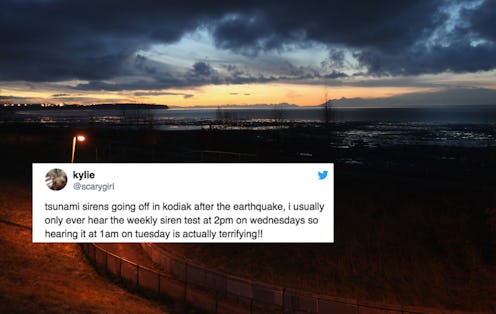News
These Scary Alaska Tsunami Tweets Show Just How Terrified People Were

A 7.9-magnitude earthquake that struck off the coast of Alaska early Tuesday morning led the National Weather Service to warn that a tsunami could follow along the West Coast. Residents in Alaska received cell phone text warnings and emergency storm sirens blared in Kodiak, just miles from the earthquake's epicenter. While the warning has since been lessened to an advisory, these tweets and photos about the Alaska earthquake show how scary it was for people who were there.
The key advice from officials across Alaska was to get to higher ground. The Anchorage Office of Emergency Management explained what the tsunami warning meant. "Tsunami warnings mean that a tsunami with significant inundation is possible or is already occurring. Tsunamis are a series of waves dangerous many hours after initial arrival time. The first wave may not be the largest," the office warned. Anchorage, the largest city in the state, was not in the warning area.
Even as far as California, emergency officials were warning residents of potential destruction. "If you are w/in SF & 3 blocks of the Pacific Coast or w/in 5 blocks of SF Bay, PREPARE TO EVACUATE SO YOU ARE READY IF EVACUATION IS NEEDED. Check on neighbors who may need help," the city tweeted, accompanied with photos of the warning written in other languages. The potential danger was real, and these tweets show why.
1) Sirens Go Off In Kodiak
The weather sirens went off at about 1 a.m. local time.
2) What A Tsunami Might Look Like
This graphic from the National Weather Service showed where the wave could reach — and when.
3) Local Police Sent This Warning
The Kodiak Police used Facebook to try and reach residents, urging them to make it to higher ground.
5) The Situation In Kodiak
It sounded quite chaotic, especially in the middle of the night.
6) It Was Headed Toward Washington, Too
One woman who lives on Whidbey Island in Washington was really concerned about what she was going to do.
7) That Buoy Really Had People Worried
It was the strongest evidence yet of the risk.
9) The Sirens Have People Up
The rush to reach residents happened in the middle of the night.
10) Nearby Towns Were Preparing
One woman who lives in the nearby town of Homer said she was camped out on higher ground.
12) The Earthquake Numbers Were High Too
The earthquake numbers were intense, too, one of the first indicators that there might be the risk of a tsunami.
13) Videos From The Evacuation
Cars were bumper to bumper during the evacuation.
14) The Sirens Had A Spoken Warning, Too
"Attention a Tsunami Warning has been issued for this area," blasted out in the middle of the night.
15) A Look At What Was At Stake
Much of the economic base is on or near the coast, as this Homer, Alaska, resident points out.
17) Finding Friends & Family Was Even More Important
Even if that meant heading towards the water.
18) "Do Not Wait"
Sirens also said, "Do not wait. Evacuate to high grounds, immediately." Definitely not what you want to wake up to.
19) Sirens Were Really Loud
Listen to the people trying to plan their evacuation with the overwhelming noise.
20) First News Of Relief
After being evacuated to the school, residents were finally told they were free to go.
21) During The Initial Pandemonium, No Time For Reporters
The evacuation was the main priority.
22) The Warning Was Cancelled
The National Weather Service tweeted out their cancellation of the warning.
23) The Ring Of Fire Had A Busy Day
The UN's Office for Disaster Risk Reduction pointed out that there was lots of seismic activity along the edge of the Pacific in the past day.
The potential tsunami from the Alaska earthquake was just one piece of a larger, geologic puzzle.